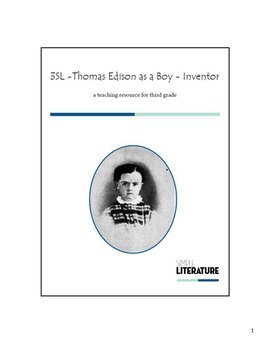3SL - Thomas Edison as a Boy - Inventor
Simple Literature
1.1k Followers
Grade Levels
3rd
Subjects
Resource Type
Standards
CCSSRL.3.1
CCSSRL.3.2
CCSSRL.3.3
CCSSRL.3.4
CCSSW.3.7
Formats Included
- PDF
Pages
18 pages
Simple Literature
1.1k Followers
Description
This curriculum helps third-grade students learn more about the inventor Thomas Edison from his exploits as a boy.
In this curriculum, you get
1) A 5-day lesson plan
2) Reading sheet created for third-grade readers
3) Deeper level thinking class discussion questions
4) Comprehension questions and a study guide
5) A class activity that focuses on making your own telegraph machine
6) A worksheet that uses the Morse Code
7) A worksheet to help kids make the front page of their own newspaper, as Thomas Edison did
8) Inquiry questions for students to dig deeper into Thomas Edison as an inventor and his life
9) Vocabulary worksheet
If you are looking for other third-grade curricula, search "3SL" on this site or browse the store: Kay's Simple Literature and Review Games. Even better, follow me, and you'll be notified when I've posted additional lessons.
“3SL – Thomas Edison as a Boy – Inventor” is copyrighted (c) 2013 by S. Kay Seifert. All rights reserved. No part of this material (in part or as a whole) may be altered. Teachers and parents may use this material for students in the classroom or at home, reproducing student sheets for personal use. This curriculum may not be commercially reproduced for print, electronic, or other formats and/or platforms, and may not be distributed electronically or commercially, unless written permission is given by S. Kay Seifert.
In this curriculum, you get
1) A 5-day lesson plan
2) Reading sheet created for third-grade readers
3) Deeper level thinking class discussion questions
4) Comprehension questions and a study guide
5) A class activity that focuses on making your own telegraph machine
6) A worksheet that uses the Morse Code
7) A worksheet to help kids make the front page of their own newspaper, as Thomas Edison did
8) Inquiry questions for students to dig deeper into Thomas Edison as an inventor and his life
9) Vocabulary worksheet
If you are looking for other third-grade curricula, search "3SL" on this site or browse the store: Kay's Simple Literature and Review Games. Even better, follow me, and you'll be notified when I've posted additional lessons.
“3SL – Thomas Edison as a Boy – Inventor” is copyrighted (c) 2013 by S. Kay Seifert. All rights reserved. No part of this material (in part or as a whole) may be altered. Teachers and parents may use this material for students in the classroom or at home, reproducing student sheets for personal use. This curriculum may not be commercially reproduced for print, electronic, or other formats and/or platforms, and may not be distributed electronically or commercially, unless written permission is given by S. Kay Seifert.
Total Pages
18 pages
Answer Key
Included
Teaching Duration
1 Week
Report this resource to TPT
Reported resources will be reviewed by our team. Report this resource to let us know if this resource violates TPT’s content guidelines.
Standards
to see state-specific standards (only available in the US).
CCSSRL.3.1
Ask and answer questions to demonstrate understanding of a text, referring explicitly to the text as the basis for the answers.
CCSSRL.3.2
Recount stories, including fables, folktales, and myths from diverse cultures; determine the central message, lesson, or moral and explain how it is conveyed through key details in the text.
CCSSRL.3.3
Describe characters in a story (e.g., their traits, motivations, or feelings) and explain how their actions contribute to the sequence of events.
CCSSRL.3.4
Determine the meaning of words and phrases as they are used in a text, distinguishing literal from nonliteral language.
CCSSW.3.7
Conduct short research projects that build knowledge about a topic.





